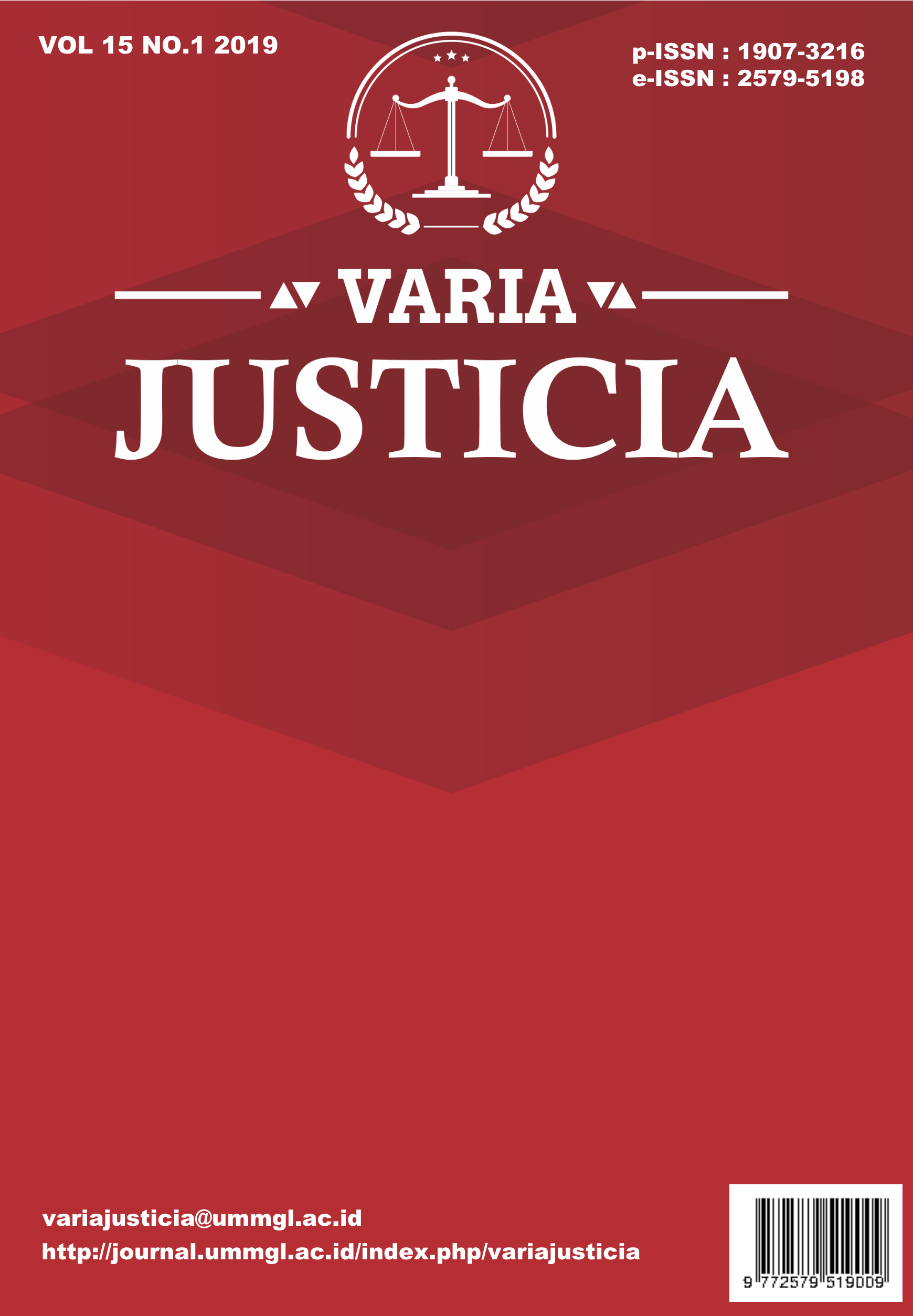Main Article Content
Abstract
This study aims to identify the causes and formulate a regulatory model for the eradication of Corruption in regional infrastructure development funds in Indonesia. This research was conducted by examining cases and laws related to Corruption. Some of the causes of corruption in regional development funds are: 1)Historical Factors; 2)Economic Factors; 3)Cultural Factors and 4)Institutional Factors. Although all four factors have been identified, there are still many countries that have not succeeded in eradicating corruption. An extraordinary crime requires extraordinary effort. The Government of Indonesia needs to formulate legislative policies with those manifested in specific deviant provisions. In addition, there are four approaches that are needed, namely legal approach, moralistic-religious approach, socio-cultural approach, and educational approaches. Massive actions must also be taken in various regions to start an anti-corruption measure.
Keywords
Article Details
References
- Bach, T., & Wegrich, K. (2018). Politicians and Bureaucrats in Executive Government. The Oxford Handbook of Political Executives.
- Beirne, P., & Messerschmidt, J. W. (2005). Criminology. Oxford University Press. Retrieved from https://books.google.co.id/books?id=gjtOPgAACAAJ
- Buley, N. V., Demchenko, T. S., Makushkin, S. A., Vinichenko, M. V., & Melnichuk, A. V. (2016). Human resource management in the context of the global economic crisis. International Journal of Economics and Financial Issues, 6(Special Issue), 160–165.
- Denisova-schmidt, E. (2018). Corruption, the Lack of Academic Integrity and Other Ethical Issues in Higher Education: What Can Be Done Within the Bologna Process? European Higher Education Area: The Impact of Past and Future Policies. Springer International Publishing. https://doi.org/10.1007/978-3-319-77407-7
- Gyimah-Brempong, K. (2002). Corruption, economic growth, and income inequality in Africa. Economics of Governance, 3(3), 183–209. https://doi.org/10.1007/s101010200045
- Hadiz, V. R., & Robison, R. (2013). The political economy of oligarchy and the reorganization of power in Indonesia. Indonesia, 96(Special Issue), 35–57. https://doi.org/10.5728/indonesia.96.0033
- Heilbrunn, J. R. (2004). Anti-Corruption Commissions Panacea or Real Medicine to Fight Corruption? Washington. Retrieved from http://siteresources.worldbank.org/WBI/Resources/wbi37234Heilbrunn.pdf
- Lee, W. S., & Guven, C. (2013). Engaging in corruption: The influence of cultural values and contagion effects at the microlevel. Journal of Economic Psychology, 39(7685), 287–300. https://doi.org/10.1016/j.joep.2013.09.006
- Lindgreen, A. (2004). Corruption and unethical behavior: Report on a set of Danish guidelines. Journal of Business Ethics, 51(1), 31–39. https://doi.org/10.1023/B:BUSI.0000032388.68389.60
- Liu, Q., Lu, R., & Ma, X. (2015). Corruption, Financial Resources and Exports. Review of International Economics, 23(5), 1023–1043. https://doi.org/10.1111/roie.12194
- Man-wai, T. K. (2010). Investigation of Corruption Cases (96 No. 79). Retrieved from http://www.unafei.or.jp/english/pdf/RS_No79/No79_19VE_Man-wai2.pdf
- Melgar, N., Rossi, M., & Smith, T. W. (2010). The perception of corruption. International Journal of Public Opinion Research, 22(1), 120–131. https://doi.org/10.1093/ijpor/edp058
- Ochulor, C. L., & Bassey, E. P. (2010). Analysis of corruption from the ethical and moral perspectives. European Journal of Scientific Research, 44(3), 466–476.
- Prabowo, H. Y., & Kathie Cooper. (2016). Re-understanding corruption in the Indonesian public sector through three behavioral lenses. Journal of Financial Crime, 23(4), 1028–1062. https://doi.org/http://dx.doi.org/10.1108/JFC-08-2015-0039
- Santoso, Listiyono, & Meyrasyawati, D. (2015). Model Strategi Kebudayaan dalam Pemberantasan Korupsi di Indonesia. Review Politik, 5(2), 22–45.
- Siddiqui, K. (2019). Corruption and Economic Mismanagement in Developing Countries. The World Financial Review, (January-February), 50–58. Retrieved from https://www.researchgate.net/publication/331199370%0ACorruption
- Svensson, J. (2005). Eight Questions About Corruption. Journal of Economic Perspectives, 19(3), 19–42. https://doi.org/10.33119/gn/101466
- Taher, A. P. (2019, March 25). Usut Korupsi Jalan Kemiri-Depapre, KPK Panggil Sekda Papua. Tirto.Id. Retrieved from https://tirto.id/usut-korupsi-jalan-kemiri-depapre-kpk-panggil-sekda-papua-dkcW
- Transparency International. (2018). Corruption Perception Index Score 2012-2018. Retrieved from https://www.transparency.org/files/content/pages/2018_CPI_FullResults.zip
- Wimmer, A., & Feinstein, Y. (2010). The rise of the nation-state across the world, 1816 to 2001. American Sociological Review, 75(5), 764–790. https://doi.org/10.1177/0003122410382639
- Yogi Prabowo, H. (2014). To be corrupt or not to be corrupt: Understanding the behavioral side of corruption in Indonesia. Journal of Money Laundering Control, 17(3), 306–326. https://doi.org/10.1108/JMLC-11-2013-0045
- Regulations
- Undang-Undang Republik Indonesia Nomor 31 Tahun 1999 tentang Pemberantasan Tindak Pidana Korupsi (Law of the Republic of Indonesia Number 31 of 1999 concerning Corruption Eradication)
- Undang-Undang Republik Indonesia Nomor 20 Tahun 2001 tentang Perubahan Atas Undang-Undang Nomor 31 Tahun 1999 (Law of the Republic of Indonesia Number 20 of 2001 concerning Amendment to Law Number 31 of 1999)
- Undang-Undang Republik Indonesia Nomor 30 Tahun 2002 tentang Komisi Pemberantasan Korupsi (Law of the Republic of Indonesia Number 30 of 2002 concerning Corruption Eradication Commission)
